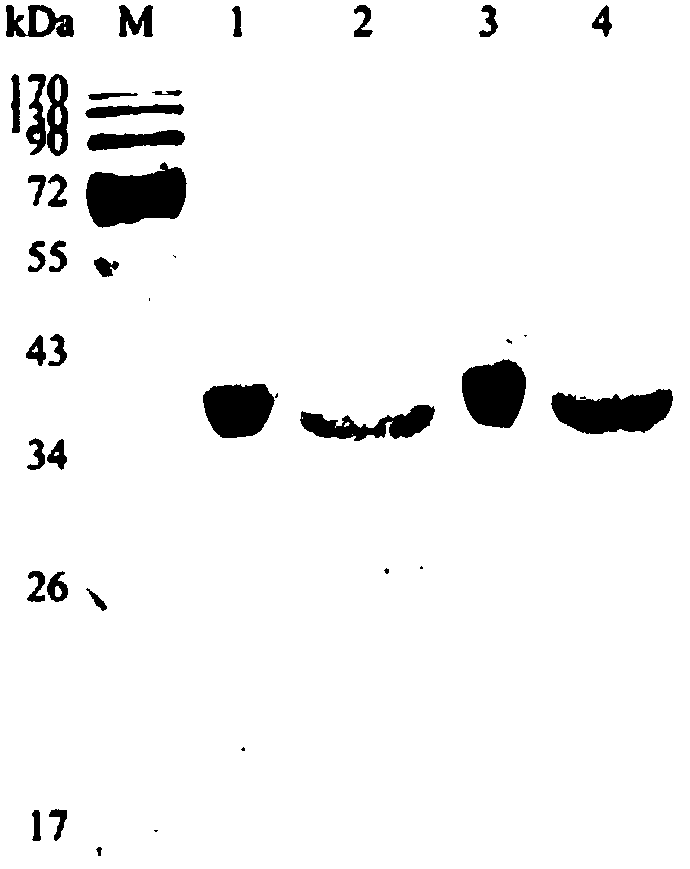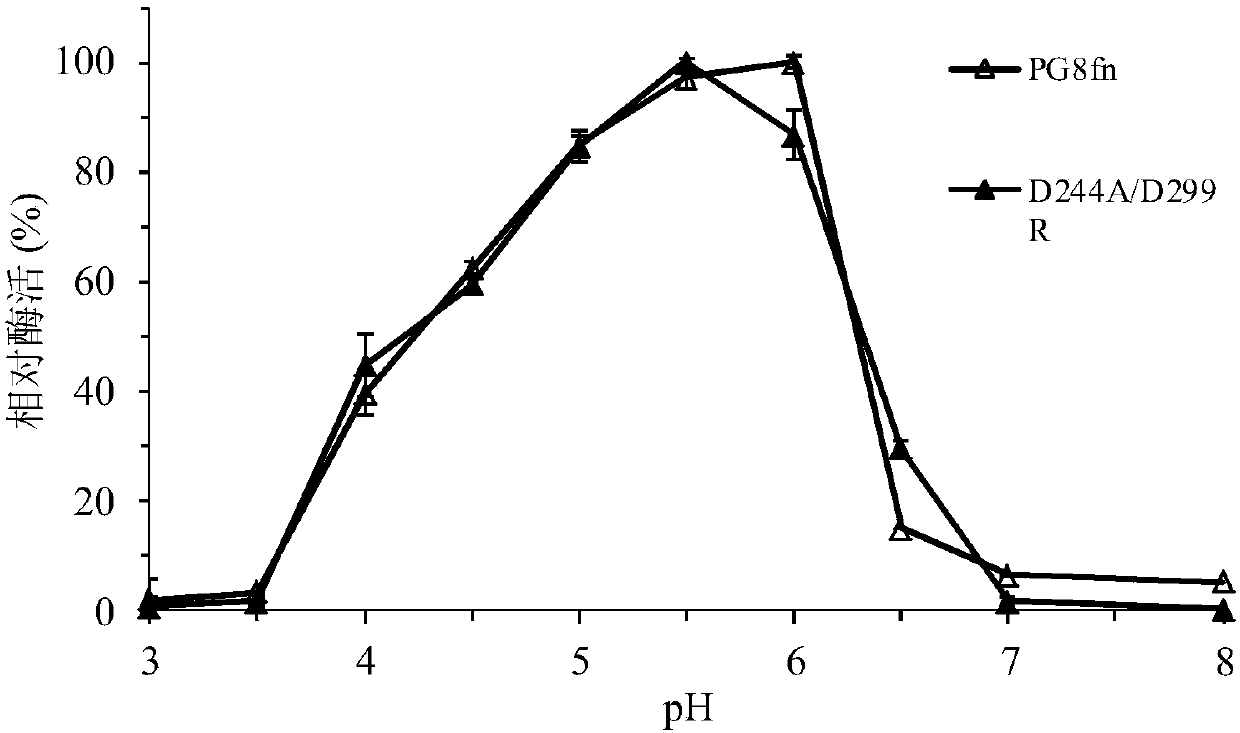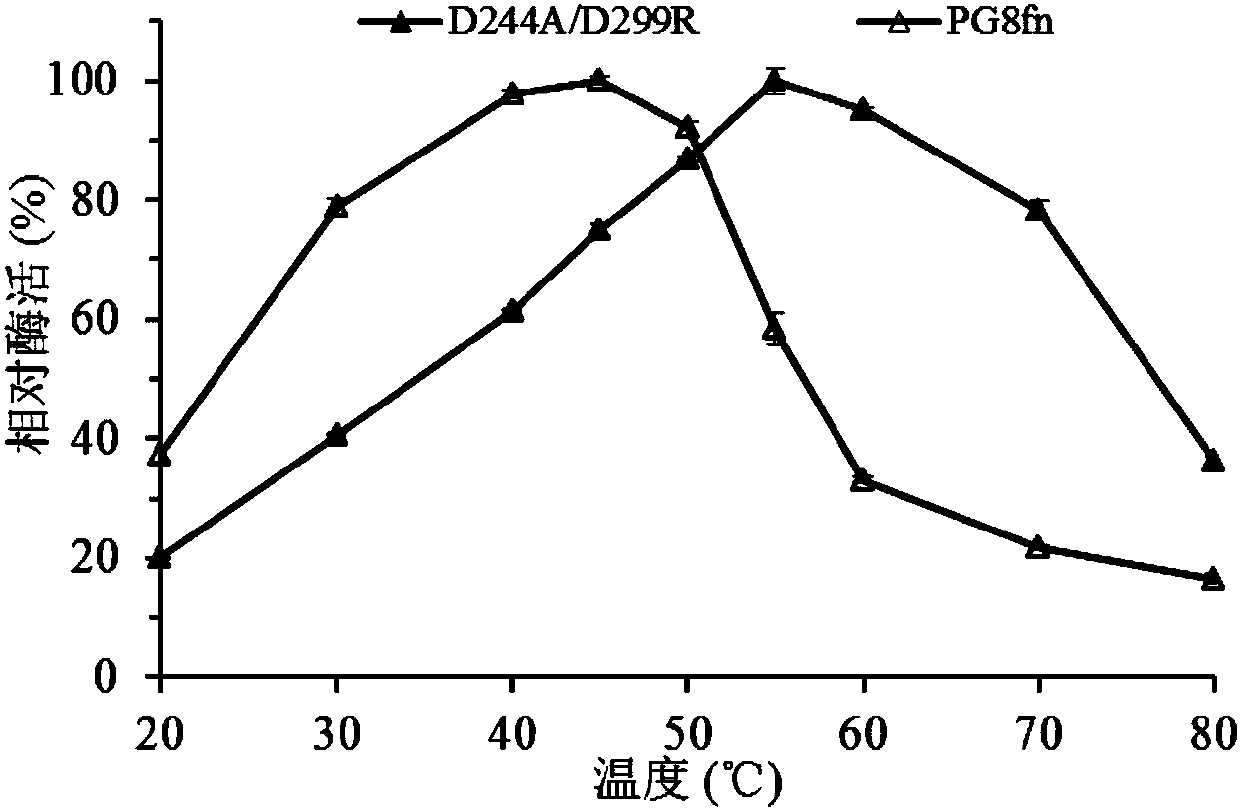A kind of heat-resistant chaetomium polygalacturonase mutant and its coding gene and application
A technology of polygalactose and coding genes, which is applied in the field of genetic engineering and can solve problems such as poor thermal stability, increased production costs, and easy inactivation
- Summary
- Abstract
- Description
- Claims
- Application Information
AI Technical Summary
Problems solved by technology
Method used
Image
Examples
Embodiment 1
[0055] Example 1 Site-directed mutagenesis
[0056] Carry out homology modeling on polygalacturonase PG8fn (Tu et al., 2013), and design the mutation site as the 244th aspartic acid is mutated to alanine and the 299th aspartic acid Mutated to arginine. The primers used in the design are shown in Table 1:
[0057] Table 1. The mutant-specific primers
[0058]
Embodiment 2
[0059] Preparation of mutants described in Example 2.
[0060] The expression vector pPIC9r was subjected to double enzyme digestion (SnaB I+Not I), and simultaneously the gene ASA encoding the mutant was double enzyme digested (SnaB I+Not I), and the gene fragment encoding the mature mutant was cut ( Remove the signal peptide fragment) and connect with the expression vector pPIC9r to obtain the recombinant plasmid pPIC9r-ASA containing the mutant gene ASA and transform it into Pichia pastoris GS115 to obtain the recombinant yeast strain GS115 / ASA.
[0061] Take the GS115 strain containing the recombinant plasmid, inoculate it in a 1L Erlenmeyer flask with 300mL of BMGY medium, place it at 30°C, and culture it on a shaker at 220rpm for 48h; then centrifuge the culture solution at 3000g for 5min, discard the supernatant, and use 100mL of 0.5% methanol for precipitation. The BMMY medium was resuspended, and placed again at 30°C, 220rpm to induce culture. Add 0.5 mL of methanol ...
Embodiment 3
[0064] Activity analysis of embodiment 3 mutant and wild type
[0065] 1. DNS method: The specific method is as follows: under the given pH and temperature conditions, 1mL of the reaction system includes 100μL of appropriate diluted enzyme solution, 900μL of substrate, react for 10min, add 1.5mL of DNS to terminate the reaction, and boil for 5min. After cooling, the OD value was measured at 540 nm. One enzyme activity unit (U) is defined as the amount of enzyme required to decompose polygalacturonic acid to generate 1 μmol D-(+)-galacturonic acid per minute under given conditions.
[0066] 2. Determination of the properties of mutants and wild types
[0067] 1. The optimal pH determination method of mutant and wild type is as follows:
[0068] The mutant enzyme purified in Example 2 and the wild type were subjected to enzymatic reactions at different pHs to determine their optimum pH. The substrate polygalacturonic acid was tested for polygalacturonase activity in 0.1mol / L ...
PUM
| Property | Measurement | Unit |
|---|---|---|
| half-life | aaaaa | aaaaa |
| melting point | aaaaa | aaaaa |
Abstract
Description
Claims
Application Information
 Login to View More
Login to View More - R&D
- Intellectual Property
- Life Sciences
- Materials
- Tech Scout
- Unparalleled Data Quality
- Higher Quality Content
- 60% Fewer Hallucinations
Browse by: Latest US Patents, China's latest patents, Technical Efficacy Thesaurus, Application Domain, Technology Topic, Popular Technical Reports.
© 2025 PatSnap. All rights reserved.Legal|Privacy policy|Modern Slavery Act Transparency Statement|Sitemap|About US| Contact US: help@patsnap.com



